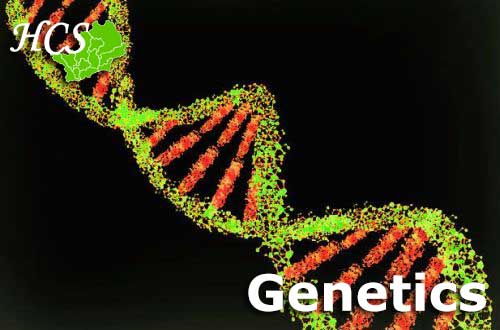Genetics
Our risk of many common diseases is influenced by a combination of the genes we inherited from our ancestors and our lifestyle and environment. Our genes are building blocks that are made up of DNA. This DNA effectively acts as the instruction manual for our bodies. Layered on top of this are epigenetic factors – which influence how our genes are read. Epigenetic factors are very important as unlike the genes we inherit they can be changed – for example by environmental factors like cigarette smoking – and epigenetic changes can also be passed down across generations. This is really important to us as we believe it is one way that we can explain why events early in someone’s life – or even in their parent’s or grandparent’s life – can affect their own health. We have performed a number of genetic and epigenetic studies over the years with the help of our HCS participants, as shown in the list below. Many of these have used blood samples, but some have tested epigenetic factors using muscle biopsies, as we explain in greater detail below.
Sarcopenia, the loss of skeletal muscle mass and function with age, is common in men and women over the age of 65 and is associated with a number of adverse health outcomes including frailty, disability, and osteoporosis. Although age, gender, body size, genetic inheritance, nutrition and physical activity are known to influence amount and quality of muscle in later life, there is a lot that we don’t know about muscle mass and strength among older people.
The MEMOSA study (Multi-Ethnic MOlecular determinants of human SArcopenia) and the Hertfordshire Sarcopenia Study (HSS) are trying to answer some of these questions using cell and molecular biology. We are trying to identify changes in the body’s cells and molecules which explain why some people develop sarcopenia and some people do not. As part of MEMOSA and HSS, a group of male and female participants from the 1930’s Hertfordshire cohort spent a day at a clinical research facility at Southampton General Hospital; they had their muscle mass and function measured and also donated a small amount of their leg muscle, through biopsy, to be used in this research. They also gave blood, had a DXA scan to measure muscle mass, and completed physical performance tests which included measurement of grip strength and walking speed. We have collected the same information from groups of older people in Singapore and Jamaica.
We are using the latest cutting edge scientific techniques to investigate genetic and epigenetic pathways in sarcopenia. For example, we are investigating whether the expression of genes associated with cellular pathways is altered during muscle ageing and how this contributes to sarcopenia. We are also studying genes associated with inflammation, mitochondrial function and the regulation of muscle growth. We are also taking the novel approach of investigating epigenetic pathways by studying DNA methylation markers in muscle tissue and also in cultured primary skeletal muscle cells, a Southampton first.
The results from this work will give us clues about how sarcopenia begins, progresses, and what can be done to prevent or treat it. Our research will help to identify people at risk of sarcopenia and will contribute to efforts to find treatments to slow the progression, or stop the development, of sarcopenia. For example, if there is evidence in sarcopenic muscle of altered inflammation, mitochondrial function or epigenetic markers, the hope is that drugs could be tailored to modify these changes to give better muscle mass, strength and quality.
Some examples of publications describing this research are provided below.
Reference List
Burton MA, Antoun E, Garratt ES, Westbury L, Dennison EM, Harvey NC, Cooper C, Patel HP, Godfrey KM, Lillycrop KA. The serum small non-coding RNA (SncRNA) landscape as a molecular biomarker of age associated muscle dysregulation and insulin resistance in older adults. FASEB J. 2024 Feb 15;38(3):e23423. doi: 10.1096/fj.202301089RR. PMID: 38294260; PMCID: PMC10952661.
Burton MA, Garratt ES, Hewitt MO, Sharkh HY, Antoun E, Westbury LD, Dennison EM, Harvey NC, Cooper C, MacIsaac JL, Kobor MS, Patel HP, Godfrey KM, Lillycrop KA. DNA methylation of insulin signaling pathways is associated with HOMA2-IR in primary myoblasts from older adults. Skelet Muscle. 2023 Oct 28;13(1):17. doi: 10.1186/s13395-023-00326-y. PMID: 37898813; PMCID: PMC10612387.
Burton MA, Antoun E, Garratt ES, Westbury L, Baczynska A, Dennison EM, Harvey NC, Cooper C, Patel HP, Godfrey KM, Lillycrop KA; EpiGen Global Research Consortium. Adiposity is associated with widespread transcriptional changes and downregulation of longevity pathways in aged skeletal muscle. J Cachexia Sarcopenia Muscle. 2023 Aug;14(4):1762-1774. doi: 10.1002/jcsm.13255. Epub 2023 May 18. PMID: 37199333; PMCID: PMC10401538.
Antoun E, Garratt ES, Taddei A, Burton MA, Barton SJ, Titcombe P, Westbury LD, Baczynska A, Migliavacca E, Feige JN, Sydall HE, Dennison E, Dodds R, Roberts HC, Richardson P, Sayer AA, Shaw S, Cooper C, Holbrook JD, Patel HP, Godfrey KM, Lillycrop KA; EpiGen Global Research Consortium. Epigenome-wide association study of sarcopenia: findings from the Hertfordshire Sarcopenia Study (HSS). J Cachexia Sarcopenia Muscle. 2022 Feb;13(1):240-253. doi: 10.1002/jcsm.12876. Epub 2021 Dec 4. PMID: 34862756; PMCID: PMC8818655.
Warner SC, Walsh DA, Laslett LL, Maciewicz RA, Soni A, Hart DJ, Zhang W, Muir KR, Dennison EM, Leaverton P, Rampersaud E, Cooper C, Spector TD, Cicuttini FM, Arden NK, Jones G, Doherty M, Valdes AM. Pain in knee osteoarthritis is associated with variation in the neurokinin 1/substance P receptor (TACR1) gene. Eur J Pain. 2017 Aug;21(7):1277-1284. doi: 10.1002/ejp.1027. Epub 2017 May 11. PMID: 28493529; PMCID: PMC5511507.
Valdes AM, Arden NK, Vaughn FL, Doherty SA, Leaverton PE, Zhang W, Muir KR, Rampersaud E, Dennison EM, Edwards MH, Jameson KA, Javaid MK, Spector TD, Cooper C, Maciewicz RA, Doherty M. Role of the Nav1.7 R1150W amino acid change in susceptibility to symptomatic knee osteoarthritis and multiple regional pain. Arthritis Care Res (Hoboken). 2011 Mar;63(3):440-4. doi: 10.1002/acr.20375. Epub 2010 Oct 28. PMID: 21031562.
Dennison EM, Syddall HE, Jameson KA, Sayer AA, Gaunt TR, Rodriguez S, Day IN, Cooper C, Lips MA; Hertfordshire Cohort Study Group. A study of relationships between single nucleotide polymorphisms from the growth hormone-insulin-like growth factor axis and bone mass: the Hertfordshire cohort study. J Rheumatol. 2009 Jul;36(7):1520-6. doi: 10.3899/jrheum.081061. Epub 2009 Jun 1. PMID: 19487270.
Lips MA, Syddall HE, Gaunt TR, Rodriguez S, Day IN, Cooper C, Dennison EM; Southampton Genetic Epidemiology Research Group. Interaction between birthweight and polymorphism in the calcium-sensing receptor gene in determination of adult bone mass: the Hertfordshire cohort study. J Rheumatol. 2007 Apr;34(4):769-75. Epub 2007 Feb 15. PMID: 17309124; PMCID: PMC2136207.
Dennison E, Syddall H, Fall C, Brandi ML, Cooper C; Hertfordshire Cohort Study Group. Evidence of sexual dimorphism in relationships between estrogen receptor polymorphisms and bone mass: the Hertfordshire study. J Rheumatol. 2005 Dec;32(12):2400-4. PMID: 16331771.
Rodríguez S, Gaunt TR, Dennison E, Chen XH, Syddall HE, Phillips DI, Cooper C, Day IN. Replication of IGF2-INS-TH*5 haplotype effect on obesity in older men and study of related phenotypes. Eur J Hum Genet. 2006 Jan;14(1):109-16. doi: 10.1038/sj.ejhg.5201505. PMID: 16251897.

